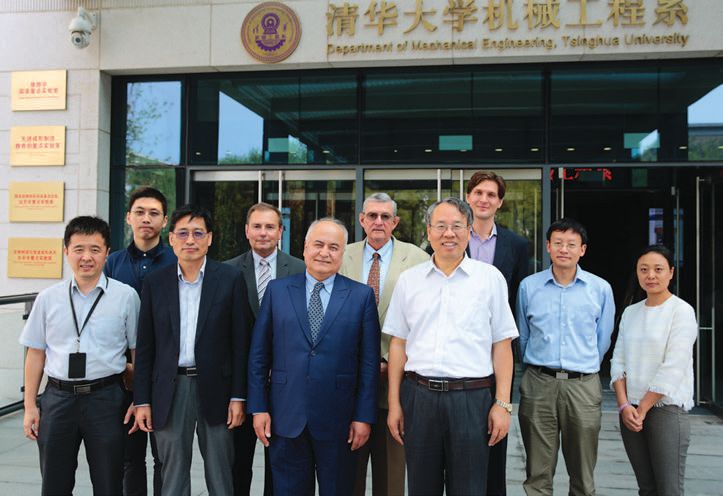Discovering the future in Beijing
Edward P. Salek, CAE, Executive Director | TLT Headquarters Report November 2016
China to host the World Tribology Congress Sept. 17-22, 2017.

As part of its global advocacy strategy, STLE representatives recently met with the Chinese Tribology Institute in Beijing to help plan the 2017 World Tribology Congress.
STLE TRAVELS RECENTLY TOOK ME TO THE HISTORIC Tsinghua University campus in Beijing, China. The school’s tribology program is one of the many reasons Tsinghua is regarded as one of China’s top universities. Correction: one of the world’s top universities.
Tsinghua, established in 1911, is rated 35th overall and 23rd for engineering and technology by the N.Y. Times in its world university rankings. Tsinghua alumni include China’s current President Xi Jinping, who graduated with a degree in chemical engineering in 1979. His predecessor, Hu Jintao, also was a Tsinghua engineering graduate.
The visit culminated a week-long series of events and meetings in China. Joining me as the STLE delegation were President Ali Erdemir (Argonne National Laboratory) and STLE director of professional development Robert Gresham. The Tsinghua host committee was led by professor Jianbin Luo, chair of the department of mechanical engineering and recipient of the STLE 2013 International Award. We began the day with a tour of the tribology laboratories, which are housed in the school’s spacious new mechanical engineering building.
Researchers using the laboratories rely on test machines and instrumentation that cost hundreds of thousands of dollars (or yuan in this case). To the untrained observer, many of these expensive tools look more like a kitchen appliance or some sort of wacky gadget created for a junior high school science fair. The observer also might question if anything significant could be happening in these small rooms that are often tucked away in the obscure corner of a massive building.
Of course, first impressions can be deceiving. Theories and ideas examined during hours of testing and analysis in these basement laboratories sometimes evolve into the methods and products that can change the world and benefit millions of people. Machines, blended with the ingenuity of discerning scientists and engineers, are able to literally unlock secrets and work feats of engineering magic.
Almost one year to the day from our visit, more than 1,000 of the world’s top tribologists will come together to share thoughts on how they can harness the power of those test machines. The Sixth World Tribology Congress (WTC 2017) will be held in Beijing Sept. 17-22, 2017. WTC 2017 (www.wtc2017.org) is organized by the Chinese Tribology Institute (CTI). It is expected that more than 800 oral presentations, including plenary, keynote and invited talks, will be given in nine technical tracks. Around 200 poster presentations also are expected. In addition, CTI and STLE are planning a one-day education program on Efficiency and Energy Saving in Advanced Manufacturing prior to the start of the conference.
WTC 2017 aims to highlight recent important progress in all aspects of tribology and strengthen the links between academia and industry. This level of global collaboration is a pathway to solving critical technical problems in manufacturing, energy production and use, transportation, greenhouse emissions, health care, infrastructure maintenance and reliability and many other needs.
Which brings us back to the Tsinghua campus visit. It is part of an outreach program that supports STLE’s strategic plan goal to be a global advocate for the profession. Implementation of that goal relies in part on collaboration with the CTI to make the WTC a success. In addition to assisting with program development and marketing, STLE plans to release the new version of its Emerging Trends in Tribology and Lubrication Engineering report in conjunction with the WTC. The new report will expand on the themes introduced in the 2014 version, which emphasizes tribology’s role in solving global problems.
By creating greater recognition for tribology as a scientific discipline, this sort of global advocacy also creates support for increased research and development investments in the field, especially here in the U.S. The possibility of more research funding is another example of how an organization like STLE can use its stature on the global stage to create outcomes that work to the benefit of our individual members and their employers who support STLE.

You can reach Certified Association Executive Ed Salek at esalek@stle.org.